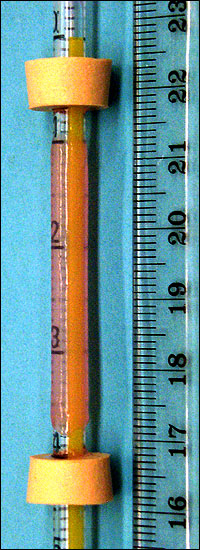Archives
Engineered blood vessels function like native tissue
By ELLEN GOLDBAUM
Contributing Editor
Blood vessels that have been tissue-engineered from bone marrow adult stem cells may in the future serve as a patient's own source of new blood vessels following a coronary bypass or other procedures that require vessel replacement, according to new research from the Department of Chemical and Biological Engineering.

UB researchers tissue-engineered this blood vessel from bone marrow adult stem cells.
It was published recently in Cardiovascular Research.
"Our results show that bone marrow is an excellent source of adult stem cells containing smooth muscle and endothelial cells, and that these stem cells can be used in regenerative medicine for cardiovascular applications," said Stelios T. Andreadis, associate professor in the Department of Chemical and Biological Engineering in the School of Engineering and Applied Sciences.
Andreadis co-authored the paper with Jin Yu Liu, lead author and a postdoctoral researcher in Andreadis' lab.
The research demonstrates the potential for eventually growing tissue-engineered vessels out of stem cells harvested from the patients who need them, providing a desirable alternative to the venous grafts now routinely done in patients undergoing coronary bypass operations.
Disadvantages with venous grafts include limited availability of vessels, pain and discomfort at the donor site and a high 10-year failure rate.
The UB researchers developed a novel method for isolating functional smooth muscle cells from bone marrow by using a fluorescent marker protein and a tissue-specific promoter for alpha-actin, a protein found in muscles that is responsible for their ability to contract and relax.
Although not yet strong enough for coronary applications, the UB group's tissue-engineered vessels (TEVs) performed similarly to native tissue in critical ways, including their morphology, their expression of several smooth muscle cell proteins, the ability to proliferate and the ability to contract in response to vasoconstrictors, one of the most important properties of blood vessels.
The TEVs also produced both collagen and elastin, which give connective tissue their strength and elasticity, and are critical to the functioning of artificial blood vessels.
"These are the first tissue-engineered vessels to demonstrate the ability to make elastin in vivo," said Andreadis.
In addition, the smooth muscle cells isolated from the bone marrow are mesenchymal cells; that is, stem cells that can differentiate into several cell types.
Several studies have shown that mesenchymal stem cells may be immunoprivileged, which means they will not trigger an immune reaction when transplanted into another individual, Andreadis said.
"If true, this means that you may be able to develop a universal cell source for smooth muscle cells so that you could potentially make these vessels into an 'off-the-shelf' product, available to any patient," Andreadis said.
The TEVs were implanted into sheep and functioned normally for five weeks.
Andreadis' group now is working on ways to make the TEVs stronger. It also is studying the differences between stem cells taken from older versus younger individuals, work that is being funded by the John R. Oishei Foundation.
Co-authors on the paper with Andreadis and J.Y. Liu include Daniel D. Swartz, research assistant professor at Women and Children's Hospital of Buffalo; Sylvia F. Gugino, senior research support specialist; James A. Russell of the UB Department of Physiology and Biophysics; and Hao Fan Peng, graduate student in the Department of Chemical and Biological Engineering.
Funding for the work came from UB's Integrative Research and Creative Activities Fund in the Office of the Vice President for Research.
